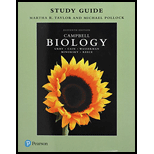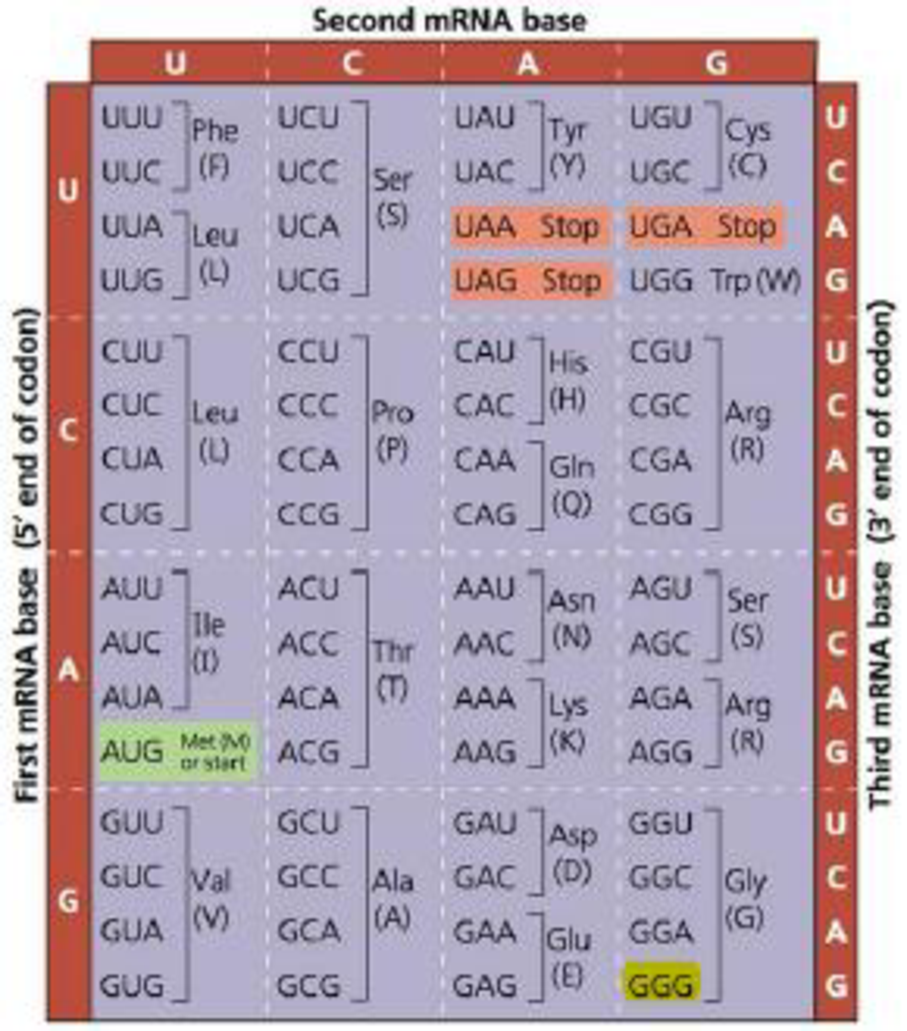
Concept explainers
- a. In what three ways does RNA differ from DNA?
- b. Fill in the following sequence in the flow of genetic information, often called the central dogma. Above each arrow, write the name of the process involved.
Figure 17.6 The codon table for mRNA. The three

VISUAL SKILLS A segment in the middle of an mRNA has the sequence 5′-AGAGAACCGCGA-3′. Using the codon table, translate this sequence, assuming the first three nucleotides are a codon.
a.
To determine: Three ways in which ribonucleic acid (RNA) differs from deoxyribonucleic acid (DNA).
Introduction: Nucleic acids are the major organic molecules of all living organisms. Nucleic acids are made of three major components, such as nitrogenous base, pentose sugar, and phosphate group. The two major nucleic acids are deoxyribonucleic acid (DNA) and ribonucleic acid (RNA). DNA carries the genetic information from one generation to other generation. DNA controls the synthesis of RNA in the cell. RNA is responsible for the synthesis of protein molecules.
Explanation of Solution
Three ways in which DNA differ from RNA are given below:
| Criteria | DNA | RNA |
| Pentose sugar | DNA contains deoxyribose pentose sugar. | RNA contains ribose pentose sugar. |
| Nitrogenous base | DNA has 4 nitrogenous bases, namely adenine, cytosine, guanine, and thiamine. | RNA has 4 nitrogenous bases, namely adenine, cytosine, guanine, and uracil. |
| Strand | DNA is double-stranded. | RNA is single-stranded. |
b.
To fill and name: The given sequence in the flow of genetic information and the process involved in it.
Introduction: The central dogma of biology explains the flow of information from genes to protein by two processes. These two processes are transcription and translation.
Explanation of Solution
The given sequence in the flow of genetic information and the process involved in it is as follows:
Transcription is a process in which a DNA sequence is converted into a functional piece of RNA. In the initiation of transcription, RNA polymerase binds to the sequence of DNA, and then the unbinding of DNA strand takes place. RNA polymerase adds the RNA bases to the DNA that creates a single strand of mRNA. RNA polymerase detaches from the sequence, and the newly formed sequence of mRNA is released into the nuclear fluid, and then it leaves the nucleus.
After the transcription, the newly formed mRNA enters the cytosol. In the cytosol, processed mRNA associates with many ribosomes. The complex of ribosome-mRNA starts the process of translation. At the initiation of translation, anticodons that appear on tRNA attaches with the mRNA codon. This attachment of tRNA and mRNA codon corrects the orientation of newly arrived amino acids. These amino acids are linked together by a peptide bond, and a peptide chain starts to grow.
Transcription is the formation of RNA from a DNA sequence and through the process of translation, protein is formed from the RNA.
Want to see more full solutions like this?
Chapter 17 Solutions
Study Guide for Campbell Biology
- Describe and give a specific example of how successionary stage is related to species diversity?arrow_forwardExplain down bellow what happens to the cell in pictures not in words: Decreased pH in mitochondria Increased ATP Decreased pH in cytosol Increased hydrolysis Decreasing glycogen and triglycerides Increased MAP kinase activity Poor ion transport → For each one:→ What normally happens?→ What is wrong now?→ How does it mess up the cell?arrow_forward1.) Community Diversity: The brown and orange line represent two different plant communities. a. Which color represents the community with a higher species richness? b. Which color represents the community with a higher species evenness? Relative abundance 0.1 0.04 0.001 2 4 6 8 10 12 14 16 18 20 22 24 Rank abundance c. What is the maximum value of the Simpson's diversity index (remember, Simpson's index is D = p², Simpson's diversity index is 1-D)? d. If the Simpson's diversity index equals 1, what does that mean about the number of species and their relative abundance within community being assessed?arrow_forward
- 1.) Community Diversity: The brown and orange line represent two different plant communities. a. Which color represents the community with a higher species richness? b. Which color represents the community with a higher species evenness? Relative abundance 0.1 0.04 0.001 2 4 6 8 10 12 14 16 18 20 22 24 Rank abundance c. What is the maximum value of the Simpson's diversity index (remember, Simpson's index is D = p², Simpson's diversity index is 1-D)? d. If the Simpson's diversity index equals 1, what does that mean about the number of species and their relative abundance within community being assessed?arrow_forwardwhat measures can a mother to take to improve the produce of her to milk to her newborn baby ?arrow_forward1. Color the line that represents all ancestors of the Eastern white pine tree green (but only the ancestral line NOT shared with other organisms) 2. Oncle the last common ancestor of the Colorado blue spruce tree and Eastern white pine tree. 3. Put a box around the last common ancestor of the sugar maple tree and the dogwood tree. 4. Put a triangle around the last common ancestor of the red pine tree and the american holly bush. 5. Color the line that represents all ancestors of the Ponderosa pine tree red (including all shared ancestors). 6. Color the line that represents all ancestors of the American elm tree blue (including all shared ancestors). 7 Color the line that represents all ancestors of the Sabal palm tree purple (including all shared ancestors) 8. Using a yellow highlighter or colored pencil, circle the clade that includes all pine trees. 9. Using a orange highlighter or colored pencil, circle the clade that includes all gymnosperms 10. Can you tell…arrow_forward
- You have been hired as a public relations specialist to give invertebrates a good name. After all, they are much more than just creepy crawly bugs! Your first task though is to convince yourself that is true. The best way to do that is to start close to home. Find something in your house that is a product obtained directly from an invertebrate or only due to an invertebrate’s actions. Describe the product, its function and utility, as well as any human manufactured alternatives. Be sure to highlight the advantages of obtaining this directly from nature. Keep in mind, a product can be something you use, wear, eat, or enjoy for its visual appeal.arrow_forwardUse the following tree diagram to answer Questions #8-10. 8) Which of the following two animals are the most closely related based on the tree to the left? a) Pig and camel b) Hippo and pig c) Deer and cow 9) CIRCLE on the tree diagram where the common ancestor between a hippo and a cow is. 10) Put a SQUARE on the tree diagram where the common ancestor between a pig and a peccary is.arrow_forwardExplain: Healthy Cell Function Overview→ Briefly describe how a healthy cell usually works: metabolism (ATP production), pH balance, glycogen storage, ion transport, enzymes, etc. Gene Mutation and Genetics Part→ Focus on the autosomal recessive mutation and explain: How gene mutation affects the cell. How autosomal inheritance works. Compare the normal and mutated gene sequences simply. → Talk about possible consequences of a faulty hydrolytic enzyme.arrow_forward
- Can you fill out those termsarrow_forwardExplain down bellow what happens to the cell: Decreased pH in mitochondria Increased ATP Decreased pH in cytosol Increased hydrolysis Decreasing glycogen and triglycerides Increased MAP kinase activity Poor ion transport → For each one:→ What normally happens?→ What is wrong now?→ How does it mess up the cell?arrow_forwardAn 1100 pound equine patient was given 20 mg/kg sucralfate 3 times a day, 2.8 mg/kg famotidine twice a day, and 10mg/kg doxycycline twice a day. Sucralfate comes as a 1 gm tablet, famotidine as 20 mg tablets, and doxycycline as 100mg tablets. All are in bottles of 100 tablets.How many total mg are needed for the patient and how many tablets of each would be needed to provide each dose?How many bottles of each would be needed to have available if this patient were to be on this drug regimen for 5 days?arrow_forward
 Biology (MindTap Course List)BiologyISBN:9781337392938Author:Eldra Solomon, Charles Martin, Diana W. Martin, Linda R. BergPublisher:Cengage Learning
Biology (MindTap Course List)BiologyISBN:9781337392938Author:Eldra Solomon, Charles Martin, Diana W. Martin, Linda R. BergPublisher:Cengage Learning Human Heredity: Principles and Issues (MindTap Co...BiologyISBN:9781305251052Author:Michael CummingsPublisher:Cengage Learning
Human Heredity: Principles and Issues (MindTap Co...BiologyISBN:9781305251052Author:Michael CummingsPublisher:Cengage Learning Biology Today and Tomorrow without Physiology (Mi...BiologyISBN:9781305117396Author:Cecie Starr, Christine Evers, Lisa StarrPublisher:Cengage Learning
Biology Today and Tomorrow without Physiology (Mi...BiologyISBN:9781305117396Author:Cecie Starr, Christine Evers, Lisa StarrPublisher:Cengage Learning
 BiochemistryBiochemistryISBN:9781305577206Author:Reginald H. Garrett, Charles M. GrishamPublisher:Cengage Learning
BiochemistryBiochemistryISBN:9781305577206Author:Reginald H. Garrett, Charles M. GrishamPublisher:Cengage Learning Biology 2eBiologyISBN:9781947172517Author:Matthew Douglas, Jung Choi, Mary Ann ClarkPublisher:OpenStax
Biology 2eBiologyISBN:9781947172517Author:Matthew Douglas, Jung Choi, Mary Ann ClarkPublisher:OpenStax





